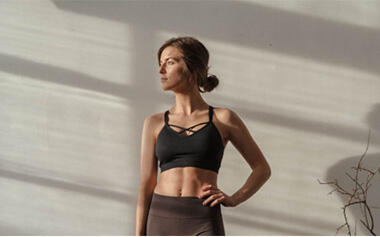Yoga on nopeasti kasvava suosituksi, ja sen suosion myötä myös hyviä yoga-vaatteita koskeva markkinatila kasvaa. On siis olennaista keskittyä käytettävän kankaanlajin valintaan suunnittellessa harjoitusvaatteita, jotta voidaan täyttää mainitut tekijät. Tarkastellaan myös erilaisia kankaanlajeja pyrkimyksenä auttaa sinua valitsemaan oikea kanne yoga-vaatteillesi.
Miksi kankaiden valinta on tärkeää
Tämä on jotakin yogasta, jossa vaatteiden materiaalien valinta vaikuttaa suoraan kokeemukseen. Olipa sinulla sitten alaspäin koirassa vai kopassa täydellisessä asennossa, oikea materiaali tekee valtavasti eroa. Se määrittää, kuinka hyvin näiden ominaisuuksien toimii vaatteiden hengittämiskyvyn, venymiskyvyn, himojen vetämiskyvyn ja halutun muodon säilyttämiskyvyn suhteen. Väärän materiaalin käyttäminen voi olla epämiellyttävää, kirsuvaista tai jopa häiritsevää ja aiheuttaa haasteita henkilölle, joka harjoittaa mielenterveyden tai jopa meditaation perusteita.
Joitakin yogamateriaalien ominaisuuksia
Kuitenkin on tärkeää tietää vaatimuksista, jotka tekevät materiaalista ideaalisena käytettäväksi yogavaatteissa ennen kuin mennään syvemmälle käytettyjen materiaalien tyyppiin. Tässä on joitakin keskeisiä ominaisuuksia, joita pitää etsiä:
Hengittävyys: Ilma kulkee läpi materiaalin, mikä tekee sinusta tunteeltaan kylmämmäksi ja mukavammaksi.
Himojen vetäminen: Himo vedetään pois iholta sen varmistamiseksi, että iho pysyy kuivana.
Joustavuus: Joustava vaate, joka voi muuttua asemia liikkeessä mukana kehon liikkeiden mukaan, mahdollistaa täyden liikkumisen.
Kestävyys: Tarkemmin ottaen, korkealaatuiset kudot pysyvät kestävinä ajassa ja jatkuvan käytön jälkeen eivät hämärty myöskään niin helposti.
Pehmeys: Hymy kevyesti ihoasi vähentää ihoirtoja.
Suosittuja kudosia yoga-vaatteille
1. Pehmeä villapuu
Petta on monipuolinen kudo, joka kuuluu luonnonkuitujen joukkoon, se on orgaanista ja sisältää joitakin parhaita ominaisuuksia, kuten pehmeys ja hengittelykyky. Se mahdollistaa riittävän ilman vaihteen annetussa ympäristössä, mikä tekee siitä mukavan pukea erityisesti intensiivisten harjoitusten aikana. Kuitenkin petan sulatuskyky on rajoitettu ja se naputtaa hienoja, joten se tulee painavaksi ennen. Se on hyvä hieman pehmeämpien yogamuotojen tai meditaatiotehtävien suorittamiseen, mutta ei välttämättä optimaalinen korkeakovaisten tehtävien suorittamiseen.
2. Polyyesteeri
Polyesteri on ihmisen tekemä materiaali, jota käytetään laajasti urheiluvaatteissa sen kykyjen takia siirtää kosteutta. Se vedostaa hiekkaa sulasta varmistaakseen, ettei sinun tarvitse hikoilevat koko harjoitusajan kentällä. Lisäksi polyesteri on suhteellisen kevyt, se kestää myös melko pitkän, väsymättömän käytön eikä kutista. Vaikka se ei ehkä ole niin pehmeä kuin luonnonkierron kotot, mikä voi tehdä siitä vähemmän hengittävän, se voi olla ongelma niille, jotka ehtevät hikoilevat treenissä.
3. Nylon
Toinen synteettinen materiaali, jota käytetään usein yogahenkilöiden vaatekannessa, on nilon. Se auttaa antamaan erinomaista venymiskykyä, mikä myös lievittää kankaan tiukkuutta, ja siksi se on kuuluisa aktiivisissa liikkeissä. Lisäksi nilon ei vedä kosteutta, ja siksi tämä materiaali pitää sinut kuivana heti kun hikoilet. Yksi sen ainutlaatuisista ominaisuuksista on pehmeä silkkiarvo, mikä tekee siitä loistavan valinnan yogasessioillesi. Kuitenkin tämä materiaali, kuten polyesteri, voi olla epämiellyttävä iältä vasten ja ei ole yhtä ilmankuudenta kuin jotkut muut orgaaniset kaudet, kuten nilon.
4. Spandex (Lycra tai Elastane)
Monissa tapauksissa spandexiä käytetään muiden vaatekangasten kanssa parantaakseen niiden joustavuutta. Tarkemmin ottaen tämä syntettinen kemiallinen materiaali venyy viiteen kertaan sen alkuperäiseen pituuteen ja tarjoaa mukavaa liikkumista yogatunnilla. Spandex tukee kangasaineen 'kiinnitys' -ominaisuutta ja antaa käyttäjälle mukavan sovittuvuuden. Vaikka puhtaata spandexia ei yleensä käytetä kokonaan vaatteiden valmistuksessa, sitä sekoitetaan usein muita kuituja, kuten nilkkia tai polyesteriä.
5. Bambooa
Muita viime aikoina huomion saaneita kuituja ovat bambookuudosta tehtyjä kuituja. Se on erittäin silkkaa, porokasta ja se vie kosteutta. Toinen hyvin hyödyllinen ominaisuus bambookuitussa on, että se on hipoallerginen ja antibakteerinen, mikä tekee siitä sopivan herkkien ihojen tuotteisiin. Bamboo on paras mukavuuden ja ympäristöystävällisyyden kannalta, mutta se ei välttämättä kestä niin kauan kuin jotkut syntettiset kuitujen.
Ulkonäön kaksi näkökohtaa: toiminto ja muoti
Monet ihmiset odottavat laatua ja tyyliä myös yogapukeutuksestaan, ei vain harjoittelun toteuttamista. Onneksi nykymaailmassa sekä tyyli että käytännöllisyys voidaan helposti saavuttaa kankaissa.
Kankaaselementtien seos sopii parhaiten jokapäiväisiin tarpeisiin ja mieltymyksiin, kun kyse on tyylestä, riippumatta siitä, oletko kiinnostunut enemmän leikkeistä ja muodoista vai graafikoista. Valitse yogapukeutus, joka yhdistää paras tasapaino voimaan ja suunnitteluun ottamalla huomioon yogapukeutuksesi ihaalit.
Johtopäätös
Parhaan kankaan valinta yoga-vaatteisiin vaihtelee aina henkilöltä toiseen, sillä se riippuu heidän erityisistä mieltymyksistään ja epämieltymyksistään. Vaikka puhdas puu on ideaalinen vähemmän intensiivisille sesseille tarjoaakseen ensimmäiselle istuntojaksolle suurta mukavuutta ja hengittelykykyä, aktiivisempiin harjoituksiin sopii paremmin polyesteeri- ja nilonimateriaalien himojen vetopitoisuuden ja vahvan kestovuuden toiminnallisuus. Spandex-sekoitukset mahdollistavat liikkumisen tarvitsemalla joustavuudella ja sovittelulla. Basmati taas on ekoystävällinen ja iholle soveltuva valinta.
Kuten sopiva vaateiden valinta, niin myös keskeiset kankaan ominaisuudet, kuten hengittelykyky, vetopitoisuus, joustavuus, kestovuus ja pehmeys auttavat sinua valitsemaan paras materiaali yhdistämään yogaharjoitteluun. Oikea yhdistelmä voi parantaa ja helpottaa yogakokemustasi sekä varmistaa keskittymisen tarvittaviin asenteisiin ja niiden kautta syvempään hyvinvointiin.
 EN
EN
 AR
AR BG
BG HR
HR CS
CS DA
DA NL
NL FI
FI FR
FR DE
DE EL
EL IT
IT NO
NO PL
PL PT
PT RO
RO RU
RU ES
ES SV
SV CA
CA TL
TL ID
ID LV
LV LT
LT SR
SR SK
SK UK
UK SQ
SQ ET
ET GL
GL HU
HU TR
TR FA
FA MS
MS GA
GA CY
CY IS
IS KA
KA
